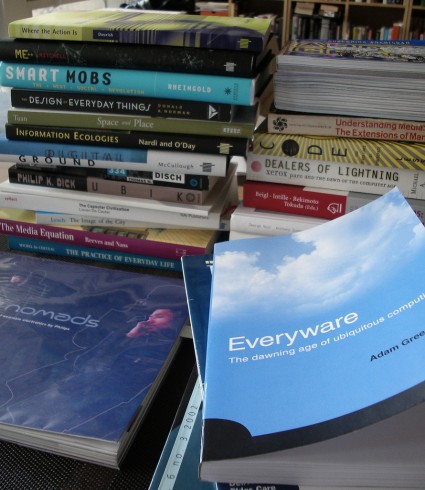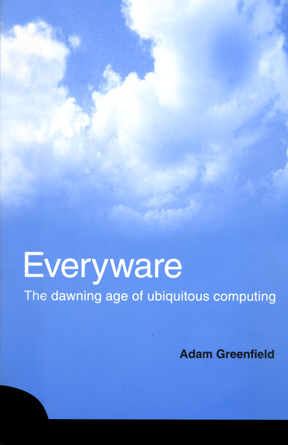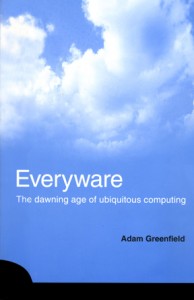I finally got around last month to reading Adam Greenfield’s Everyware: The Dawning Age of Ubiquitous Computing.
I was concerned at first when I picked it up, thinking that any book written in 2005 and published in 2006 that claims to cover ubiquitous computing would obviously be horribly out of date, and at best interesting for historical perspective, but I was wrong.
It’s a fantastic book, and as timely as ever.
It’s not a “how-to” guide (more of a “how-not-to guide” in fact) or a technical reference to the hardware and software of ubicomp, but an extended essay, delivered as a set of 81 theses, all but the last of which is followed by a brief explication.
The theses themselves are broken down into sections:
- What is everyware? (Theses 1-8)
- How is everyware different from what we’re used to? (Theses 9-23)
- What’s driving the emergence of everyware? (Theses 24-33)
- What are the issues we need to be aware of? (Theses 34-46)
- Who gets to determine the shapre of everyware? (Theses 47-51)
- When do we need to begin preparing for everyware? (Theses 52-69)
- How might we safeguard our prerogatives in an everyware world? (Theses 70-81)
Greenfield’s writing is masterful: this is the kind of book I would like to have written. He’s neither technophile nor luddite: not falling into technical determinism but also not oblivious to the impact technologies can have on the societies which make them. He’s careful not to claim to have all the answers, yet still establishes by iteration a clear way of understanding the changes and challenges that make up ubiquitous / pervasive computing in all its possibilities and threats. It’s a theoretical book, to be sure, but never feels far from practice, and is clearly rooted in a strong understanding of how things actually get designed and made (and sold, and resold, and imitated, and used for unintended purposes . . . ).
The theses-based approached can come across at times as a bit too mystical for me – as though they’re trying to be modern-day Zen koans. For example, the concluding thesis (81):
These principles are necessary but not sufficient: they constitute not an end but a beginning.
The reality though is that throughout the primary text of the book the thesis have a kind of epigrammatic relationship to the chapters they announce, and are simple and clear: telegraphing meaning, not obscuring it. A few other examples:
Thesis 01: There are many ubiquitous computings.
Thesis 34: Everyware insinuates itself into transactions never before subject to technical intervention.
Thesis 48: Those developing everyware may have little idea that this is in fact what they are doing.
In the end Greenfield stakes a claim that in essence ubiquitous computing / pervasive computing necessitates a design intervention: that if we’re not careful about how we design and develop pervasive computing systems we’ll end up taking everything bad about desktop computing and making it ubiquitous, making systems that get in our way as much as (or more than) they help us. Pervasive computing will force re-evaluation and reconsideration of notions of privacy and appropriate behavior even more than the internet has, as everyware essentially drives the ongoing blending of the digital into everyday life.

As I said at the beginning, it’s a masterful book, densely packed with careful but suggestive ways of understanding a process that is simultaneously just getting started and (perhaps) already too far along. I don’t consider myself a ubiquitous computing or pervasive computing person – I’m generally focused on digital strategy, content management, and open source software in the web world – but I’d highly recommend everyware to anyone involved in any kind of software development, design, digital strategy, architecture, sociology, urban studies, space planning, etc. In fact I’m hard pressed to imagine a discipline or practice that wouldn’t benefit from a close reading of this book.
Further reading:
- Adam Greenfield on Everyware (UX Podcast)
- Everyware (Fabien Girardin)
- Hiding in Plain Sight (Boxes and Arrows – where I think I first heard of Everyware)
- Speedbird (Adam Greenfield’s blog)
- The Introduction to Everyware published on A List Apart
- Designing for Everyware: An Interview with Adam Greenfield (AIGA)
- Everyware: Interview with Adam Greenfield, Part I (ReadWriteWeb)
- Why the iPad May Save the Internet Fridge (Part II of the Inverview at ReadWriteWeb)
- Greenfield’s current venture: Urbanscale, and their project PERRY
- Urban Computing and Its Discontents (PDF, by Adam Greenfield and Mark Shephard, from the Situated Technologies series)>


Can I borrow that?
You can, but you’d have to borrow it from the library, where I borrowed my copy from. ;)